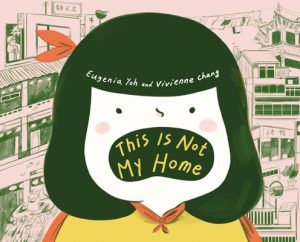 This Is Not My Home
This Is Not My Home
Written and illustrated by Eugenia Yoh and Vivienne Chang
Little Brown and Company, 2023, 44 pp (unpaged)
ISBN: 9780316377102
Adjusting to unfamiliar places can wreak havoc on oneself, and we get a first-hand look at this experience through the eyes of Lily. Lily is perfectly content where she is–in her perfectly playful bedroom, nestled inside her perfectly built home, that is perfectly surrounded by backyard barbecues, fireflies, and her U.S. friends. Mama suddenly turns Lily’s perfectly familiar world upside down by announcing that they are moving to Taiwan to take care of her Ah Ma. Readers can immediately see that this is not the news that young Lily was expecting as she points out that the unfamiliar places and people that surround her grandmother’s home are not the same as her’s. The double-spread illustration shows Lily lying down in comical protest as Mama drags her through the bustling streets of Taiwan. Further into the story, the duo of Taiwanese American authors describe Lily’s first day of school as uneventful, filled with drab classrooms contrasted by brightly illustrated classmates who don’t speak English. Lily begins to find resolution with her new surroundings when Mama points out that although these new places look unfamiliar to Lily, they represent where Mama came from and where she calls home.
The concept of home exceeds physical boundaries, also encompassing experiences, relationships, and emotions. It represents a place where people embrace their cultural heritage, express their individuality, and find a sense of belonging within that community. This picturebook invites readers to embark on the journey of a young Taiwanese American girl, raised in the United States by parents who immigrated from Taiwan, as she finds a place for herself amongst unfamiliar surroundings in Taiwan. An illustration depicting crowded Taiwanese streets filled with dismayed onlookers reiterates the feeling of not being culturally the same. The visual image marvelously portrays Lily’s feelings, creating a connection from the illustration to the reader’s heart. This is not what readers may expect to see from someone who is surrounded by their culture of origin, yet this is where the real social issue lies, as Lily faces the difficulties of navigating a culture and language that are significant to her parents and grandparents but not to her, creating a distraught sense of not belonging. This infused tone lies directly at the roots of the picturebook authors as they creatively express their own journey through its pages.
The horizontal shape of this picturebook gives the reader a sense of movement and travel. Hand-sketched illustrations, digitally colored in PhotoShop, burst from the pages. This hybrid technique blends expressionistic colors and thick brush strokes to help the reader feel the emotions of displacement that pour from the main character Lily. Selected illustrations are framed with softened edges to show how the main character is challenged by the conformity of Taiwanese culture. There is a distinctive line drawn between the narrative text moving the story forward in a black typeface-font and the emotional statement conveyed by the hand-lettered pink speech bubbles. This creative tug-of-war plays out between the book’s pages, saying both “let’s move along” from page to page and “I need your empathy” because “I don’t belong here.”
The often-muted backgrounds tell the other side of the story; the story of what surrounds Lily. Using the front jacket as an example, readers see a wailing child clothed with intense shades of yellow and red, grabbing the attention of the reader immediately. The title This Is Not My Home is boldly displayed in her mouth, pleading with the reader to notice her feelings, despite the soothing sketches of her background.
Picturebooks that touch on similar social issues are Same, Same, But Different, by Jenny Sue Kostecki-Shaw (2012). The book tells the story of two pen pals, boys living in different countries who find friendship through noticing similarities. Another great picturebook pairing would be Amah Faraway, written by Margaret Chiu Greanias, illustrated by Tracy Subisak (2022). This book tells the story of a young girl who is nervously anticipating her upcoming visit with her grandmother in Taipei. Little by little Kylie experiences cultural differences and connections that bring her even closer to her Amah.
The author-illustrator duo Vivienne Chang and Eugenia Yoh met while studying at Washington University in Saint Louis. The humdrum seclusion of the pandemic, plus the digital age of online communication, inspired the pair to draft a picturebook “about their own tale about reverse immigration, a phenomenon that is not entirely uncommon” (Mendoza, 2023). They drew inspiration from the Taiwanese-American community through interviews and through their own personal experiences. They both dream of pursuing a long-lived career in telling stories that “simplify seemingly universal ideas through humor” (Chang & Yoh, 2023). Meanwhile, Eugenia is a book designer at Chronicle Books and Vivienne works in a bank in New York.
References
Mendoza, G. (2023, January 25). Two wash. u. students are flipping the script on the immigration story with “This is not my home.” St. Louis. Retrieved July 14, 2023, from https://www.stlmag.com/.
Vivienne and Eugenia. (2023). https://www.vivienneandeugenia.com/this-is-not-my-home.
Theresa Underwood, Texas Women University
© 2023 by Theresa Underwood

